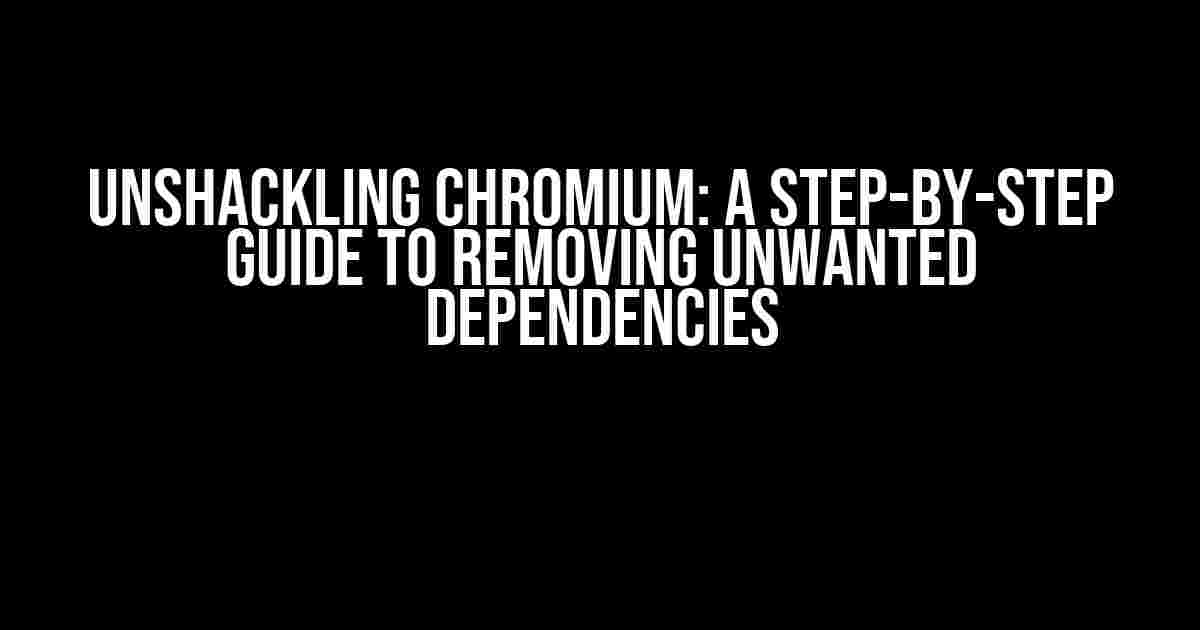Are you tired of dealing with a bloated Chromium repository, bogged down by unnecessary dependencies? Do you dream of a lean, mean, code-executing machine? Well, dream no more! In this article, we’ll take you on a journey to remove unwanted dependencies from the Chromium repository, and regain control over your codebase.
The Problem with Dependencies
Dependencies are a necessary evil in software development. They allow us to build upon the work of others, and create complex systems with ease. However, when left unchecked, dependencies can quickly spiral out of control, leading to a tangled web of interconnected code. This can result in:
- Increased build times
- Bloated binary sizes
- Reduced performance
- Security vulnerabilities
In the case of Chromium, the sheer size and complexity of the repository can make it difficult to identify and remove unwanted dependencies. But fear not, dear developer! We’re about to embark on a mission to tame the beast, and show you how to remove unwanted dependencies from the Chromium repository.
Understanding the Chromium Repository
Before we dive into the nitty-gritty of dependency removal, it’s essential to understand the structure of the Chromium repository. The Chromium project is comprised of multiple components, including:
- Chromium browser
- Chromium OS
- V8 JavaScript engine
- Blink rendering engine
- Skia graphics library
Each component has its own set of dependencies, which can make it challenging to identify and remove unwanted ones. However, by understanding the relationships between these components, we can develop a strategy for tackling the problem.
Step 1: Identify Unwanted Dependencies
The first step in removing unwanted dependencies is to identify which ones are no longer needed. This can be a daunting task, but fear not! We’ve got some tips to get you started:
- Review the Chromium documentation: The Chromium team maintains an extensive documentation set, which includes information on dependencies and their usage.
- Use dependency visualization tools: Tools like dependency-cruiser, depgraph, and graphviz can help you visualize the dependency graph, making it easier to identify unwanted dependencies.
- Analyze build logs: Reviewing build logs can help you identify which dependencies are being used, and which ones can be removed.
Let’s take a closer look at how to use dependency visualization tools to identify unwanted dependencies.
$ npm install -g dependency-cruiser $ dependency-cruiser --include-only chromium/browser --format dot | dot -Tpng > dependency_graph.png
This command uses dependency-cruiser to generate a dependency graph for the Chromium browser component, and saves it as a PNG image. By reviewing the graph, you can identify dependencies that are no longer needed, and target them for removal.
Step 2: Remove Unwanted Dependencies
Now that you’ve identified unwanted dependencies, it’s time to remove them! This can be a delicate process, as you’ll need to ensure that removing a dependency doesn’t break the build or introduce regressions. Here are some tips to keep in mind:
- Use the `git blame` command to identify the commit that introduced the dependency, and review the surrounding code changes.
- Check the Chromium documentation and API references to ensure that the dependency is no longer needed.
- Use a incremental approach, removing one dependency at a time, and re-building the project after each removal.
Let’s take a closer look at how to remove an unwanted dependency using Git.
$ git blame src/chromium/browser/dependency.cc
This command uses Git to identify the commit that introduced the unwanted dependency. By reviewing the surrounding code changes, you can ensure that removing the dependency won’t break the build.
Step 3: Verify and Test
After removing unwanted dependencies, it’s essential to verify that the build is still successful, and that the removal didn’t introduce any regressions. Here are some tips to keep in mind:
- Run the build process with the `–verbose` flag to ensure that the dependency was correctly removed.
- Use the Chromium testing infrastructure to verify that the removal didn’t break any functionality.
- Review the build logs and system logs to ensure that there are no errors or warnings related to the removed dependency.
By following these steps, you can ensure that the dependency was correctly removed, and that the Chromium repository is leaner, meaner, and more efficient.
Conclusion
Removing unwanted dependencies from the Chromium repository is a delicate process that requires patience, persistence, and attention to detail. By following the steps outlined in this article, you can identify and remove unwanted dependencies, resulting in a faster, more efficient, and more secure codebase.
Remember, every dependency removed is a battle won in the war against bloatware. So, go forth, dear developer, and tame the beast that is the Chromium repository!
| Dependency | Description | Reason for Removal |
|---|---|---|
| library1 | A utility library for string manipulation | No longer used by the Chromium browser |
| library2 | A deprecated graphics library | Replaced by Skia graphics library |
| library3 | A third-party library for compression | No longer needed due to Chromium’s compression algorithm |
This table provides an example of how to document the dependencies removed, along with the reason for removal. By maintaining a record of removed dependencies, you can track progress, and ensure that the Chromium repository remains lean and efficient.
FAQs
Frequently Asked Questions about removing unwanted dependencies from the Chromium repository:
-
Q: What if I accidentally break the build?
A: Don’t panic! Simply revert the changes, and try again. Make sure to review the build logs and system logs to identify the issue.
-
Q: How do I know if a dependency is still needed?
A: Review the Chromium documentation, API references, and the codebase to determine if the dependency is still used.
-
Q: What if I’m not sure about the impact of removing a dependency?
A: Create a test branch, and experiment with removing the dependency in isolation. This will help you identify any potential issues before committing the changes.
By following these best practices, and answering these frequently asked questions, you’ll be well on your way to removing unwanted dependencies from the Chromium repository.
Final Thoughts
Removing unwanted dependencies from the Chromium repository is a complex process, but with the right mindset, tools, and techniques, it can be a rewarding and beneficial experience. By following the steps outlined in this article, you’ll be able to:
- Reduce the size and complexity of the Chromium repository
- Improve build times and performance
- Enhance security by removing unnecessary dependencies
So, go forth, dear developer, and take the first step towards a leaner, meaner, and more efficient Chromium repository!
Frequently Asked Question
Got a chromium repository cluttered with unwanted dependencies? Don’t worry, we’ve got you covered! Here are some frequently asked questions about removing unwanted dependencies from the Chromium repository.
What’s the deal with all these dependencies in my Chromium repository?
The Chromium repository is a massive project with tons of dependencies, and it’s easy to accumulate unwanted ones over time. These dependencies can come from various sources, such as third-party libraries, build configurations, and even old code that’s no longer needed. Removing them can help declutter your repository and make it easier to maintain.
Can I just delete the unwanted dependencies manually?
Technically, yes, you can try deleting unwanted dependencies manually. However, this approach can be error-prone and time-consuming, especially if you’re dealing with a large repository. You might end up breaking something critical or missing important dependencies. Instead, it’s recommended to use a more systematic approach, like running a dependency analyzer tool or using a package manager like `git deps`.
What’s the best way to identify unwanted dependencies in my Chromium repository?
One effective way to identify unwanted dependencies is to run a dependency analyzer tool, such as `dep-cleaner` or `chromium-dependency-analyzer`. These tools can help you visualize your dependency graph and pinpoint unnecessary dependencies. You can also use `git deps` to get a list of dependencies and manually review them.
How do I remove unwanted dependencies from my Chromium repository?
Once you’ve identified unwanted dependencies, you can remove them by deleting the relevant lines from your `DEPS` file or by running `git deps` with the `–remove` flag. Make sure to test your changes thoroughly to ensure that you haven’t broken anything critical. It’s also a good idea to create a backup of your repository before making any changes.
Are there any automated tools that can help me remove unwanted dependencies?
Yes, there are automated tools that can help you remove unwanted dependencies. For example, `dep-cleaner` can automatically remove unnecessary dependencies based on your repository’s configuration. You can also use `chromium-dependency-analyzer` to identify and remove dependencies that are no longer needed. These tools can save you a lot of time and effort when cleaning up your repository.



